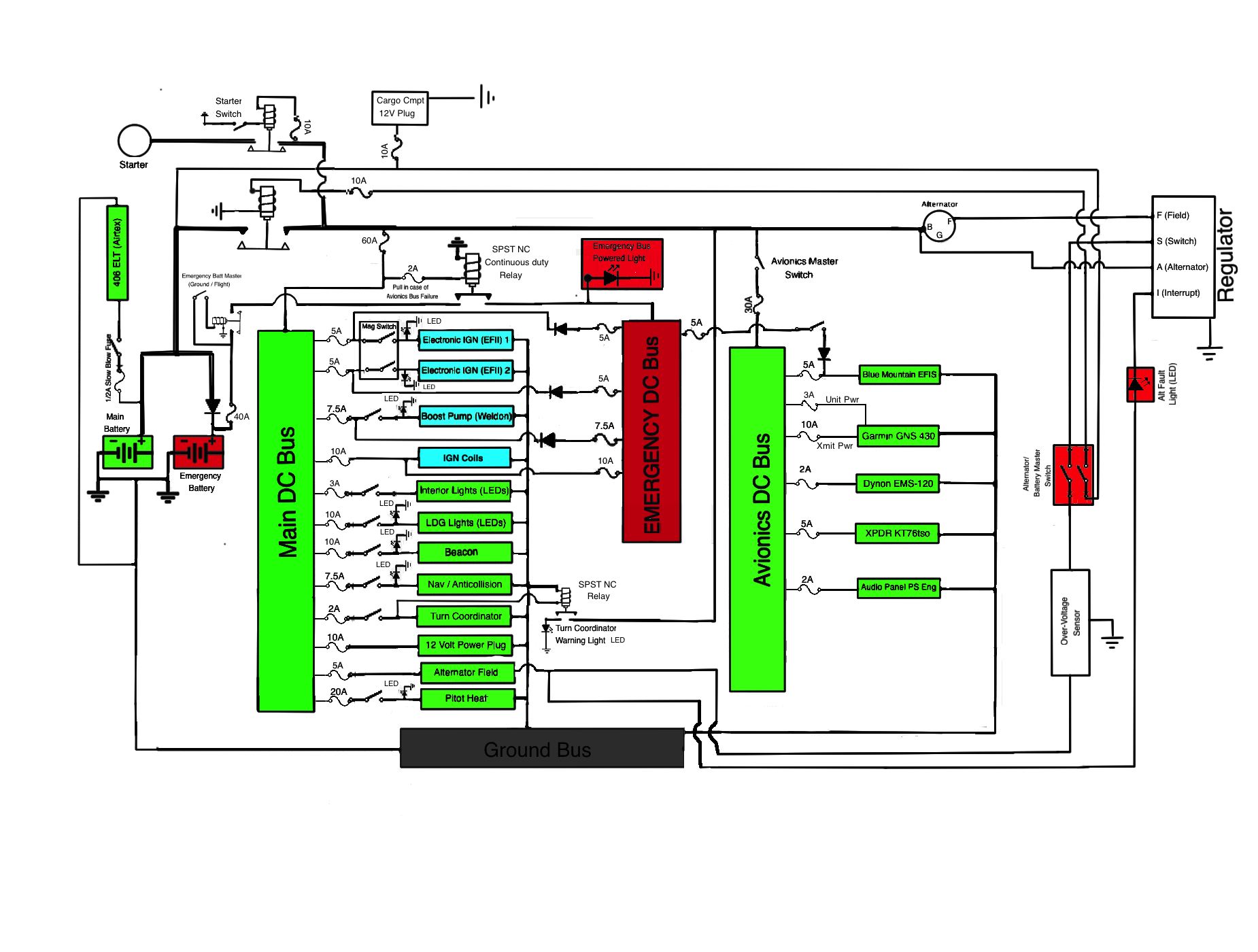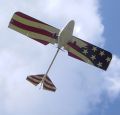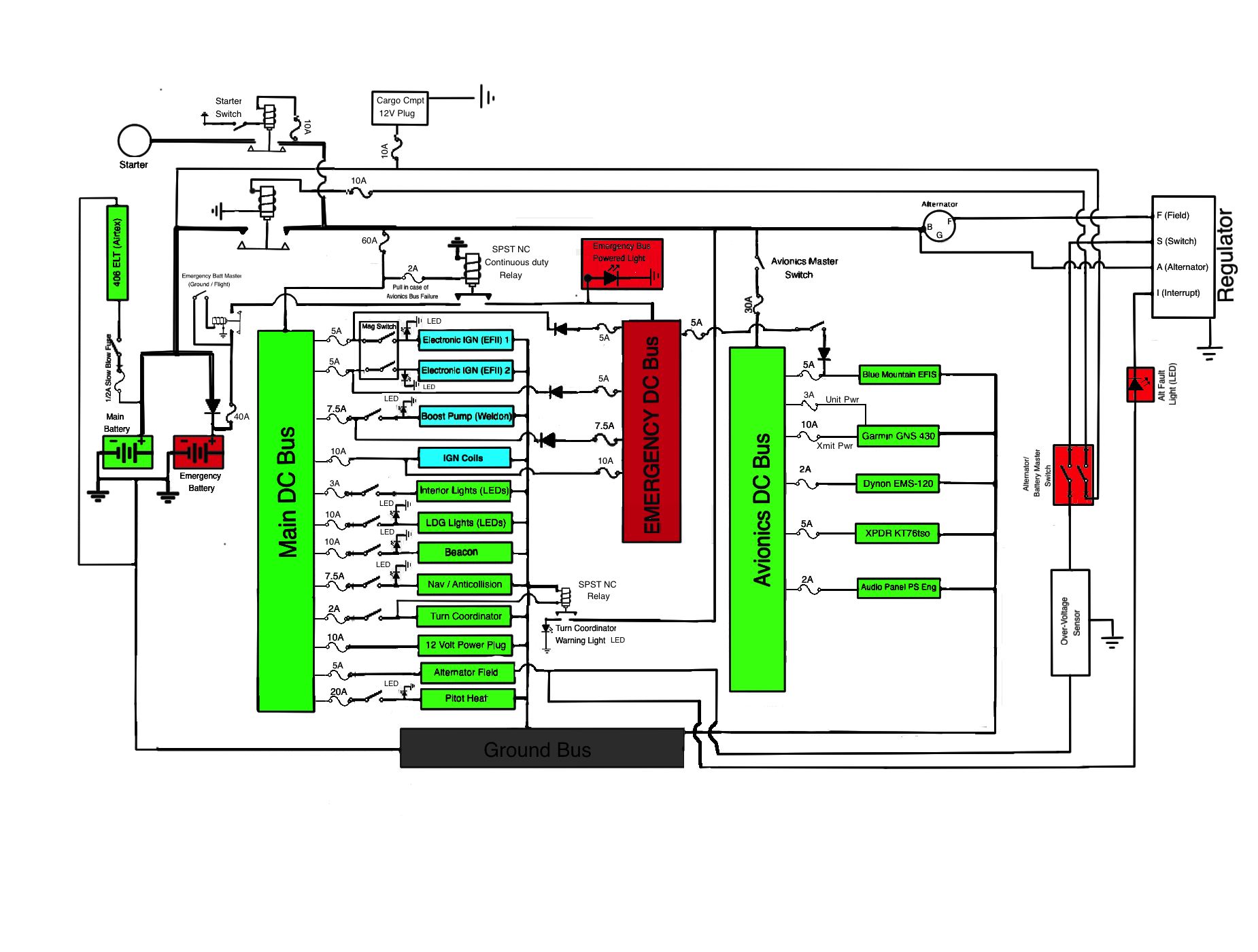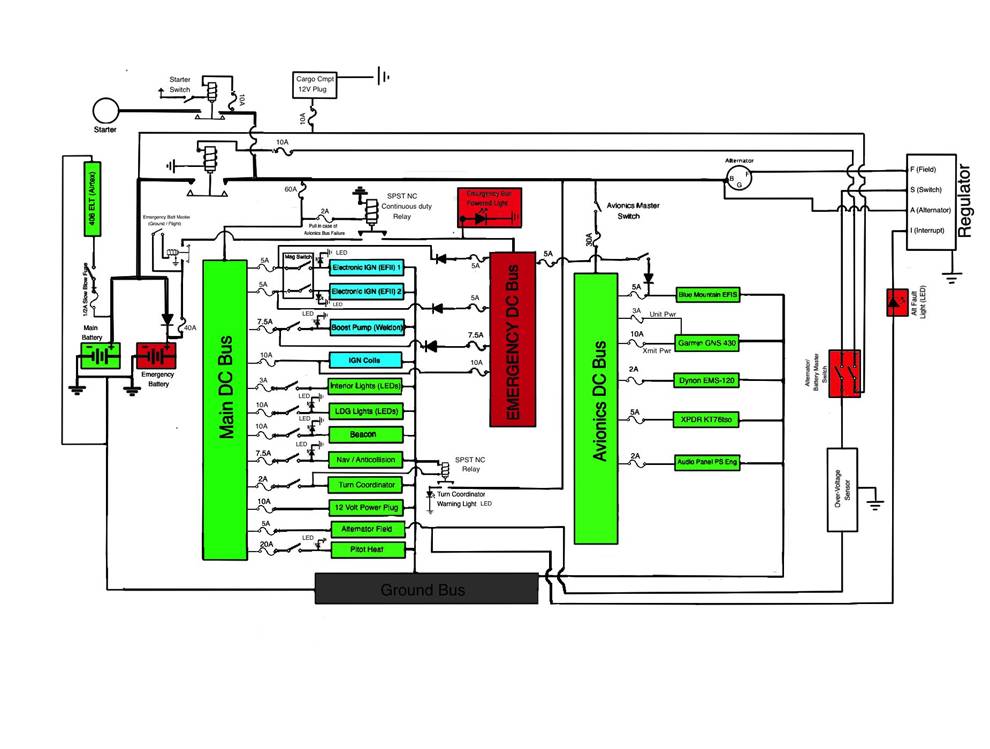 |
Matronics Email Lists
Web Forum Interface to the Matronics Email Lists
|
| View previous topic :: View next topic |
| Author |
Message |
jmjones2000(at)mindspring
Guest
|
 Posted: Mon Feb 24, 2014 7:41 am Post subject: Wiring for Aircraft With Dual Electronic Ignition Posted: Mon Feb 24, 2014 7:41 am Post subject: Wiring for Aircraft With Dual Electronic Ignition |
 |
|
I am fairly unexperienced and new at the experimental building hobby. I am building a Bushcaddy L164 and I am putting dual electronic ignition on it. I absolutely need this to work at all times since I am flying over non-forgiving terrain in Alaska. The new systems are very reliable and I am confident that with a redundant system (EIGN-4-2R through the company fly EFII ) I will be fine as long as I can supply power to the system. I have drawn up a schematic on how I plan to wire the system and wanted some input from some experts out there to see if I have done anything incorrectly. I have attached the diagram. I have also considered using solid state relays in the system. I would use them for all of the relays except the starter relay. Any thoughts on this? I have found solid state relays that are rated for all of my applications to include the Battery Master (rated at 300A continuous and 500A for 1 sec).
Thank you for your time and consideration.
Justin
[img]cid:795C8CA6-D79E-4CEE-B052-877C3D9C4705[/img]
| | - The Matronics AeroElectric-List Email Forum - | | | Use the List Feature Navigator to browse the many List utilities available such as the Email Subscriptions page, Archive Search & Download, 7-Day Browse, Chat, FAQ, Photoshare, and much more:
http://www.matronics.com/Navigator?AeroElectric-List |
|
| Description: |
|
| Filesize: |
239.07 KB |
| Viewed: |
5922 Time(s) |

|
|
|
| Back to top |
|
 |
rickofudall

Joined: 19 Sep 2009
Posts: 1392
Location: Udall, KS, USA
|
 Posted: Mon Feb 24, 2014 4:41 pm Post subject: Wiring for Aircraft With Dual Electronic Ignition Posted: Mon Feb 24, 2014 4:41 pm Post subject: Wiring for Aircraft With Dual Electronic Ignition |
 |
|
Justin, Do you have your schematic in a CAD or PDF file? Even with my bifocals some of it is difficult to make out from the small version in your email.
Thanks,
Rick Girard
do not archive
On Mon, Feb 24, 2014 at 9:39 AM, Justin Jones <jmjones2000(at)mindspring.com (jmjones2000(at)mindspring.com)> wrote:
| Quote: | I am fairly unexperienced and new at the experimental building hobby. I am building a Bushcaddy L164 and I am putting dual electronic ignition on it. I absolutely need this to work at all times since I am flying over non-forgiving terrain in Alaska. The new systems are very reliable and I am confident that with a redundant system (EIGN-4-2R through the company fly EFII ) I will be fine as long as I can supply power to the system. I have drawn up a schematic on how I plan to wire the system and wanted some input from some experts out there to see if I have done anything incorrectly. I have attached the diagram. I have also considered using solid state relays in the system. I would use them for all of the relays except the starter relay. Any thoughts on this? I have found solid state relays that are rated for all of my applications to include the Battery Master (rated at 300A continuous and 500A for 1 sec).
Thank you for your time and consideration.
Justin
[img]cid:795C8CA6-D79E-4CEE-B052-877C3D9C4705[/img]
|
--
Zulu Delta
Mk IIIC
Thanks, Homer GBYM
It isn't necessary to have relatives in Kansas City in order to be unhappy.
- Groucho Marx
| | - The Matronics AeroElectric-List Email Forum - | | | Use the List Feature Navigator to browse the many List utilities available such as the Email Subscriptions page, Archive Search & Download, 7-Day Browse, Chat, FAQ, Photoshare, and much more:
http://www.matronics.com/Navigator?AeroElectric-List |
|
| Description: |
|
| Filesize: |
239.07 KB |
| Viewed: |
5911 Time(s) |

|
_________________
The smallest miracle right in front of you is enough to make you happy.... |
|
| Back to top |
|
 |
harley(at)AgelessWings.co
Guest
|
 Posted: Mon Feb 24, 2014 5:01 pm Post subject: Wiring for Aircraft With Dual Electronic Ignition Posted: Mon Feb 24, 2014 5:01 pm Post subject: Wiring for Aircraft With Dual Electronic Ignition |
 |
|
| | - The Matronics AeroElectric-List Email Forum - | | | Use the List Feature Navigator to browse the many List utilities available such as the Email Subscriptions page, Archive Search & Download, 7-Day Browse, Chat, FAQ, Photoshare, and much more:
http://www.matronics.com/Navigator?AeroElectric-List |
|
|
|
| Back to top |
|
 |
jmjones2000(at)mindspring
Guest
|
 Posted: Mon Feb 24, 2014 9:39 pm Post subject: Wiring for Aircraft With Dual Electronic Ignition Posted: Mon Feb 24, 2014 9:39 pm Post subject: Wiring for Aircraft With Dual Electronic Ignition |
 |
|
Richard,
Thank you for looking at it for me. I do not have it in CAD, but I do have it in PDF. I have attached it. Hope this fixes the small writing.
Justin
On Feb 24, 2014, at 3:39 PM, Richard Girard <aslsa.rng(at)gmail.com (aslsa.rng(at)gmail.com)> wrote:
| Quote: | Justin, Do you have your schematic in a CAD or PDF file? Even with my bifocals some of it is difficult to make out from the small version in your email.
Thanks,
Rick Girard
do not archive
On Mon, Feb 24, 2014 at 9:39 AM, Justin Jones <jmjones2000(at)mindspring.com (jmjones2000(at)mindspring.com)> wrote:
| Quote: | I am fairly unexperienced and new at the experimental building hobby. I am building a Bushcaddy L164 and I am putting dual electronic ignition on it. I absolutely need this to work at all times since I am flying over non-forgiving terrain in Alaska. The new systems are very reliable and I am confident that with a redundant system (EIGN-4-2R through the company fly EFII ) I will be fine as long as I can supply power to the system. I have drawn up a schematic on how I plan to wire the system and wanted some input from some experts out there to see if I have done anything incorrectly. I have attached the diagram. I have also considered using solid state relays in the system. I would use them for all of the relays except the starter relay. Any thoughts on this? I have found solid state relays that are rated for all of my applications to include the Battery Master (rated at 300A continuous and 500A for 1 sec).
Thank you for your time and consideration.
Justin
<Bushcaddy L164 Wiring Diagram.jpg>
|
--
Zulu Delta
Mk IIIC
Thanks, Homer GBYM
It isn't necessary to have relatives in Kansas City in order to be unhappy.
- Groucho Marx
|
| | - The Matronics AeroElectric-List Email Forum - | | | Use the List Feature Navigator to browse the many List utilities available such as the Email Subscriptions page, Archive Search & Download, 7-Day Browse, Chat, FAQ, Photoshare, and much more:
http://www.matronics.com/Navigator?AeroElectric-List |
|
| Description: |
|

Download |
| Filename: |
Bushcaddy_L164_Wiring_DiagramPDF.pdf |
| Filesize: |
243.38 KB |
| Downloaded: |
358 Time(s) |
|
|
| Back to top |
|
 |
user9253
Joined: 28 Mar 2008
Posts: 1948
Location: Riley TWP Michigan
|
 Posted: Tue Feb 25, 2014 7:23 am Post subject: Re: Wiring for Aircraft With Dual Electronic Ignition Posted: Tue Feb 25, 2014 7:23 am Post subject: Re: Wiring for Aircraft With Dual Electronic Ignition |
 |
|
There is no fuse to protect the battery and wires from an alternator short circuit.
I assume that the LEDs have a built-in resistor.
ELTs do not normally require aircraft power.
Replace 10 amp contactor coil fuses with 3 amp.
Contactor and relay coils need diodes to short out high induced voltages.
Main buses are not normally fused. The 60 amp fuse is not big danger, but it costs money, has weight and is one more thing to go wrong.
I see no reason to have two contactors in series to feed the emergency bus. In fact, it doubles that chances of losing power to the bus.
It is good to feed the avionics bus in two places, but the 5 amp fuses might blow.
A relay is not necessary to indicate a blown turn coordinator fuse. Just put the LED in parallel with the fuse. Or buy a fuse that glows when blown, available in 3 amp or larger. Van's Aircraft sells them.
The diode will reduce charging voltage to the aux battery, not necessarily a problem. Schottky diodes drop less voltage.
There is a long, unprotected, always-hot wire between the battery and the master switch. Instead, most aircraft switch the negative side of the master contactor.
Many builders have tried to improve on Bob Nuckolls' electrical architecture, but few have succeeded. You are probably better off using one of his drawings, perhaps Z-10/8 without the dynamo circuit. http://www.aeroelectric.com/PPS/Adobe_Architecture_Pdfs/
or even one like this is much less complicated: http://forum.matronics.com/download.php?id=37766
Joe
| | - The Matronics AeroElectric-List Email Forum - | | | Use the List Feature Navigator to browse the many List utilities available such as the Email Subscriptions page, Archive Search & Download, 7-Day Browse, Chat, FAQ, Photoshare, and much more:
http://www.matronics.com/Navigator?AeroElectric-List |
|
_________________
Joe Gores |
|
| Back to top |
|
 |
user9253
Joined: 28 Mar 2008
Posts: 1948
Location: Riley TWP Michigan
|
 Posted: Tue Feb 25, 2014 7:35 am Post subject: Re: Wiring for Aircraft With Dual Electronic Ignition Posted: Tue Feb 25, 2014 7:35 am Post subject: Re: Wiring for Aircraft With Dual Electronic Ignition |
 |
|
If the emergency bus is inadvertently turned on during engine cranking, avionics bus fuses will blow.
As is, there is no brownout protection for the avionics bus during engine cranking. The aux battery could be used for that purpose.
Joe
| | - The Matronics AeroElectric-List Email Forum - | | | Use the List Feature Navigator to browse the many List utilities available such as the Email Subscriptions page, Archive Search & Download, 7-Day Browse, Chat, FAQ, Photoshare, and much more:
http://www.matronics.com/Navigator?AeroElectric-List |
|
_________________
Joe Gores |
|
| Back to top |
|
 |
Bob McC
Joined: 09 Jan 2006
Posts: 258
Location: Toronto, ON
|
 Posted: Tue Feb 25, 2014 7:37 pm Post subject: Wiring for Aircraft With Dual Electronic Ignition Posted: Tue Feb 25, 2014 7:37 pm Post subject: Wiring for Aircraft With Dual Electronic Ignition |
 |
|
Justin;
- The 10A fuse on the starter relay serves no purpose.
- Closing the switch leading from the “emergency” buss to the Blue Mountain EFIS back feeds the whole avionics buss through the 5amp fuse. It will most certainly fail. (and if the avionics master is closed also back feeds the main buss) What you’re trying to do requires a second diode coming from the avionics buss, not just the single diode you’ve shown.
- The four circuits on the left of the “emergency” buss back feed the main buss, making it impossible to isolate and also most likely the fuses will fail as they are likely not large enough in combination to support the whole of the electrical load. Guaranteed to fail if you touch the “starter” switch with the master off. Each of these four circuits, similar to above, require two diodes each to achieve what you’ve attempted to accomplish.
- The “master” switch should be switching the ground side of the master relay, not the “live”.
- I don’t see any active “low voltage” warning, unless that is the function of the circuit you’ve labeled “alt fault”?? Does your regulator support low voltage notification?? Many “alternator failure” lights do not achieve this goal.
- Does your ELT actually require aircraft power?? This is rather unusual.
- Nothing should be an “emergency”. The word should not be part of an electrical system. In Bob’s terms when the alternator fails, you revert to the pre-thought-out “plan B” which may entail switching off the main buss and relying on the “Endurance” buss for minimal electrical loads to get you to your destination. It shouldn’t constitute an “emergency”.
- “Pulling fuses” should not be part of your “plan B’ scenario, but I see a note whereby you “pull in case of buss failure”. Switches are more convenient. In a “properly designed” electrical system there is no need to have any fuses accessible in flight. Nothing individually should be “critical” and troubleshooting should be done after the flight is over, not in the air.
- Suggest reading AeroElectric connection and studying some of the “Z” drawings as most of what you are trying to achieve is elegantly covered and will allow you to fly, in the case of most failures, until you exhaust your fuel supply. (assuming proper battery maintenance)
- By all means re-invent the wheel if you wish, that’s what “experimental” is all about, but understand what’s been developed before and the reasons behind why it’s been done the way it was, and then tweak to suit your unique requirements.
- As for your question on solid state relays, be aware that they are very reliable as long as they are properly heatsinked and kept within their ratings. We use them at work and get fantastic reliability as long as we over rate them. When operating at their design limits there are some failures, both fail open and fail closed. We’ve found that if we load them in the 30% to 50% range they are close to perfect. (no failures) Their chief advantage is very limited power consumption to operate the relay itself, conserving an extra amp or two of load to add to your battery endurance. Heat is their enemy and that’s the reason behind de-rating to ensure they stay cool. We always keep them under 50% current rating.
- Keep asking, we’ll help you sort it out to be head and shoulders better than spam cans and achieve the reliability you require.
Bob McC
From: owner-aeroelectric-list-server(at)matronics.com [mailto:owner-aeroelectric-list-server(at)matronics.com] On Behalf Of Justin Jones
Sent: Monday, February 24, 2014 10:39 AM
To: aeroelectric-list(at)matronics.com
Subject: Wiring for Aircraft With Dual Electronic Ignition
I am fairly unexperienced and new at the experimental building hobby. I am building a Bushcaddy L164 and I am putting dual electronic ignition on it. I absolutely need this to work at all times since I am flying over non-forgiving terrain in Alaska. The new systems are very reliable and I am confident that with a redundant system (EIGN-4-2R through the company fly EFII ) I will be fine as long as I can supply power to the system. I have drawn up a schematic on how I plan to wire the system and wanted some input from some experts out there to see if I have done anything incorrectly. I have attached the diagram. I have also considered using solid state relays in the system. I would use them for all of the relays except the starter relay. Any thoughts on this? I have found solid state relays that are rated for all of my applications to include the Battery Master (rated at 300A continuous and 500A for 1 sec).
Thank you for your time and consideration.
Justin
[img]cid:image002.jpg(at)01CF3279.B77CBA30[/img]
| | - The Matronics AeroElectric-List Email Forum - | | | Use the List Feature Navigator to browse the many List utilities available such as the Email Subscriptions page, Archive Search & Download, 7-Day Browse, Chat, FAQ, Photoshare, and much more:
http://www.matronics.com/Navigator?AeroElectric-List |
|
| Description: |
|
| Filesize: |
79.72 KB |
| Viewed: |
5892 Time(s) |

|
_________________
Bob McC
Falco #908
(just starting) |
|
| Back to top |
|
 |
jmjones2000(at)mindspring
Guest
|
 Posted: Wed Feb 26, 2014 8:26 am Post subject: Wiring for Aircraft With Dual Electronic Ignition Posted: Wed Feb 26, 2014 8:26 am Post subject: Wiring for Aircraft With Dual Electronic Ignition |
 |
|
Thank you all for your help and feedback! I will get on the forum and look at the diagrams and figure out something that will work for me.
Thanks again!
Justin
On Feb 25, 2014, at 6:34 PM, Bob McCallum <robert.mccallum2(at)sympatico.ca (robert.mccallum2(at)sympatico.ca)> wrote:
[quote]Justin;
- The 10A fuse on the starter relay serves no purpose.
- Closing the switch leading from the “emergency” buss to the Blue Mountain EFIS back feeds the whole avionics buss through the 5amp fuse. It will most certainly fail. (and if the avionics master is closed also back feeds the main buss) What you’re trying to do requires a second diode coming from the avionics buss, not just the single diode you’ve shown.
- The four circuits on the left of the “emergency” buss back feed the main buss, making it impossible to isolate and also most likely the fuses will fail as they are likely not large enough in combination to support the whole of the electrical load. Guaranteed to fail if you touch the “starter” switch with the master off. Each of these four circuits, similar to above, require two diodes each to achieve what you’ve attempted to accomplish.
- The “master” switch should be switching the ground side of the master relay, not the “live”.
- I don’t see any active “low voltage” warning, unless that is the function of the circuit you’ve labeled “alt fault”?? Does your regulator support low voltage notification?? Many “alternator failure” lights do not achieve this goal.
- Does your ELT actually require aircraft power?? This is rather unusual.
- Nothing should be an “emergency”. The word should not be part of an electrical system. In Bob’s terms when the alternator fails, you revert to the pre-thought-out “plan B” which may entail switching off the main buss and relying on the “Endurance” buss for minimal electrical loads to get you to your destination. It shouldn’t constitute an “emergency”.
- “Pulling fuses” should not be part of your “plan B’ scenario, but I see a note whereby you “pull in case of buss failure”. Switches are more convenient. In a “properly designed” electrical system there is no need to have any fuses accessible in flight. Nothing individually should be “critical” and troubleshooting should be done after the flight is over, not in the air.
- Suggest reading AeroElectric connection and studying some of the “Z” drawings as most of what you are trying to achieve is elegantly covered and will allow you to fly, in the case of most failures, until you exhaust your fuel supply. (assuming proper battery maintenance)
- By all means re-invent the wheel if you wish, that’s what “experimental” is all about, but understand what’s been developed before and the reasons behind why it’s been done the way it was, and then tweak to suit your unique requirements.
- As for your question on solid state relays, be aware that they are very reliable as long as they are properly heatsinked and kept within their ratings. We use them at work and get fantastic reliability as long as we over rate them. When operating at their design limits there are some failures, both fail open and fail closed. We’ve found that if we load them in the 30% to 50% range they are close to perfect. (no failures) Their chief advantage is very limited power consumption to operate the relay itself, conserving an extra amp or two of load to add to your battery endurance. Heat is their enemy and that’s the reason behind de-rating to ensure they stay cool. We always keep them under 50% current rating.
- Keep asking, we’ll help you sort it out to be head and shoulders better than spam cans and achieve the reliability you require.
Bob McC
From: owner-aeroelectric-list-server(at)matronics.com (owner-aeroelectric-list-server(at)matronics.com) [mailto:owner-aeroelectric-list-server(at)matronics.com (owner-aeroelectric-list-server(at)matronics.com)] On Behalf Of Justin Jones
Sent: Monday, February 24, 2014 10:39 AM
To: aeroelectric-list(at)matronics.com (aeroelectric-list(at)matronics.com)
Subject: Wiring for Aircraft With Dual Electronic Ignition
I am fairly unexperienced and new at the experimental building hobby. I am building a Bushcaddy L164 and I am putting dual electronic ignition on it. I absolutely need this to work at all times since I am flying over non-forgiving terrain in Alaska. The new systems are very reliable and I am confident that with a redundant system (EIGN-4-2R through the company fly EFII ) I will be fine as long as I can supply power to the system. I have drawn up a schematic on how I plan to wire the system and wanted some input from some experts out there to see if I have done anything incorrectly. I have attached the diagram. I have also considered using solid state relays in the system. I would use them for all of the relays except the starter relay. Any thoughts on this? I have found solid state relays that are rated for all of my applications to include the Battery Master (rated at 300A continuous and 500A for 1 sec).
Thank you for your time and consideration.
Justin
<image002.jpg>
[b]
| | - The Matronics AeroElectric-List Email Forum - | | | Use the List Feature Navigator to browse the many List utilities available such as the Email Subscriptions page, Archive Search & Download, 7-Day Browse, Chat, FAQ, Photoshare, and much more:
http://www.matronics.com/Navigator?AeroElectric-List |
|
|
|
| Back to top |
|
 |
|
|
You cannot post new topics in this forum
You cannot reply to topics in this forum
You cannot edit your posts in this forum
You cannot delete your posts in this forum
You cannot vote in polls in this forum
You cannot attach files in this forum
You can download files in this forum
|
Powered by phpBB © 2001, 2005 phpBB Group
|





